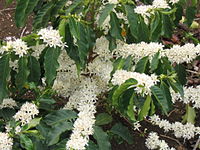
Photo from wikipedia
Abstract Parasitoids native to tropical Africa have been released in the Americas for the biological control of the coffee berry borer (CBB), but their establishment has been checkered. A tritrophic… Click to show full abstract
Abstract Parasitoids native to tropical Africa have been released in the Americas for the biological control of the coffee berry borer (CBB), but their establishment has been checkered. A tritrophic distributed maturation time model for the coffee plant – CBB – three parasitoids ( Phymastichus coffea , Cephalonomia stephanoderis , Prorops nasuta ) system was proposed by Gutierrez et al. (1998). Based on this pioneering work, and improved models for coffee and CBB (Rodriguez et al., 2011, 2013), we present an updated version of the parasitoid models. The new elements in this analysis include: 1. New data on the biology and behavior of the parasitoids are added. 2. A fourth parasitoid ( Cephalonomia hyalinipennis ) is added to the system. 3. Interspecific competitive interactions among parasitoids (e.g., dyadic contests, intra-guild predation and hyperparasitism) and their effects on the control of CBB are explored. Because field data on the effectiveness of the parasitoids on CBB control is sparse, we assessed the efficacy of the parasitoids for control of CBB heuristically. The results are compared to prior analyses, and are related to field observations. Specifically, we found: 1. Control of CBB by betilid parasitoids ( Cephalonomia stephanoderis , Cephalonomia hyalinipennis and Prorops nasuta ) is ineffective because of their low reproductive capacity relative to CBB, their host-feeding behavior, and phenological mismatches with CBB life stages. 2. Of the parasitoids, the eulophid P. coffea has the greatest potential to suppress CBB infestation levels, though the fungal pathogen B. bassiana and insecticides are reported to have detrimental effects on its establishment and dynamics.
Journal Title: Ecological Modelling
Year Published: 2017
Link to full text (if available)
Share on Social Media: Sign Up to like & get
recommendations!